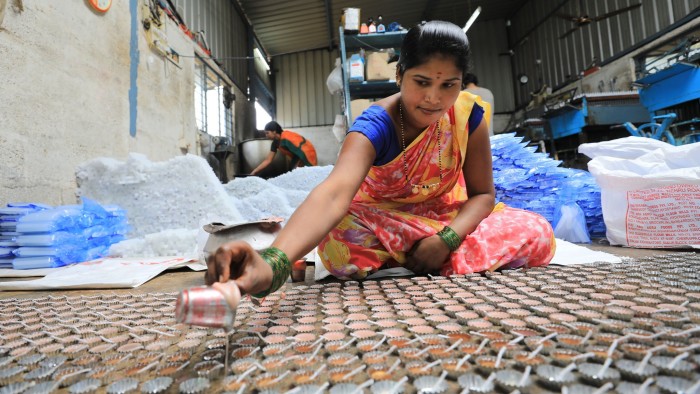India aims to capitalise on China-west tensions

Simply sign up to the Indian business & finance myFT Digest -- delivered directly to your inbox.
Kinara Capital has had a front-row view of the trends driving India’s $3.5tn economy over the past decade. Founded in 2011, as one of a new generation of small business lenders, its customers have ridden shocks ranging from a tax overhaul in 2017 to Covid-19. “During the pandemic, things were a little dicey,” says chief executive Hardika Shah.
But, after a difficult few years, Shah senses a bullish mood: “Everybody is ready to get back to business. Everybody is thinking, ‘How do I expand?’”
Kinara is one of 73 Indian businesses on the FT/Statista ranking of high-growth Asia-Pacific companies in 2023. And its customers are borrowing more than ever. Small-scale manufacturers are investing in areas such as machinery, Shah says, as they try to meet demand for auto parts and other products. Meanwhile, traders are switching en masse from the cash-based economy to a digital one, using tools such as India’s Unified Payments Interface network.
This comes as the OECD estimates that India’s economy expanded by 6.9 per cent in the financial year to March 31, making it one of the fastest growing among larger nations. Indian equities have also been star performers, internationally, since the pandemic began. India’s geopolitical heft has grown, too, as the country — which, with 1.4bn people, is set to overtake China as the world’s most populous this year — hosts the G20 summit in September.

But, at a time of global economic gloom, corporate executives and investors are watching to see whether the bullish momentum around India lasts. The country has long struggled to deliver on heady economic expectations, with repeated predictions that it would go on to recreate China’s phenomenal economic and corporate growth still unfulfilled.
Yet, with geopolitical tensions between the west and Beijing forcing investors to explore alternative investment destinations, prime minister Narendra Modi wants to promote India’s potential.
His government has announced plans to boost capital spending by a third over the fiscal year from April, to Rs10tn ($122bn), following similarly large increases in recent years, in a bid to improve infrastructure and drive growth. The budget also included tax breaks for young companies, and other steps designed to help start-ups.
Per capita growth had been in decline over the past decade, according to a recent report by the Centre for Social and Economic Progress.
While services such as IT thrived, as the country’s large pool of skilled, English-speaking engineers helped to turn India into the world’s outsourcing hub, the manufacturing sector has disappointed.
Only five Indian manufacturers make it into in this year’s FT/Statista ranking, compared with 16 businesses from the IT sector. Manufacturing as a share of gross domestic product has been similarly limited to about 15 per cent since Modi came to office in 2014, despite his multiyear “Make in India” campaign, designed to boost the industry.
Analysts say more manufacturing growth is needed to create the sort of mass employment enjoyed by China in recent decades.
New Delhi did enjoy a boost last year when Apple, which has been manufacturing low-end iPhones in India since 2017, started building its latest models in the country. But the operations remain at an early stage and beset by teething problems.
Other businesses are exploring whether to follow suit. Last month, Swedish bank SEB arranged a tour for Nordic chief executives seeking investment opportunities in India, which included meetings with officials and business leaders.
It has not yet translated into more deals, though, reports Priyanka Kishore, economic director at IMA Asia, a forum for regional executives. “When they start talking about where else to shift, India features very highly in talks,” she says. “But I’d say the execution is not at the same level as the assessment on paper.”
“They’re still not that convinced that the ecosystem for multinationals is in place,” she adds, citing the country’s inferior infrastructure and lower purchasing power compared with China.
Indian authorities are working hard to change this perception. The southern state of Karnataka, for example, this year liberalised its labour laws to allow for two-shift production — a longstanding demand from companies that say byzantine labour and land regulations put India at a disadvantage to other Asian countries.
“Those kinds of things show state governments in India becoming more business friendly, at least for big ticket investments,” says Ashish Dhawan, a private equity investor whose non-profit Convergence Foundation focuses on India’s growth and development. He adds that manufacturing “will do better, but still has long ways to go”.
India’s economy is partly shielded from global shocks thanks to its large domestic market. But it is not immune: the country’s growth is expected to slow in line with global trends, with export-oriented sectors, such as IT, particularly exposed.
After a stellar run last year, equities, too, have struggled. Markets were rocked in January and early February by fraud allegations against India’s Adani Group, one of the country’s largest private conglomerates. A sell-off among Adani’s 10 listed companies wiped more than $100bn off the value of the group, a large borrower from Indian banks.
The fallout from the allegations — which Adani vehemently denies — has been contained so far, with no sign of contagion spreading through the financial sector. But research firm Capital Economics says it expects Indian equities to remain under pressure.
Indian start-ups are also exposed to slowing global growth, which has led foreign investors to redirect funds away from emerging markets. Foreign venture capital funding of Indian start-ups has slowed sharply: falling 40 per cent, to $25.7bn, in 2022 compared with the previous year, according to data provider Tracxn.
Shah of Kinara argues that India, nonetheless, appears to be an outlier when other countries are facing recession, with more of its clients looking to hire, for example. “When I talk to my friends and family elsewhere in the world, there’s this doom and gloom sensation out there,” she says. “But India is counterintuitive.”
Comments